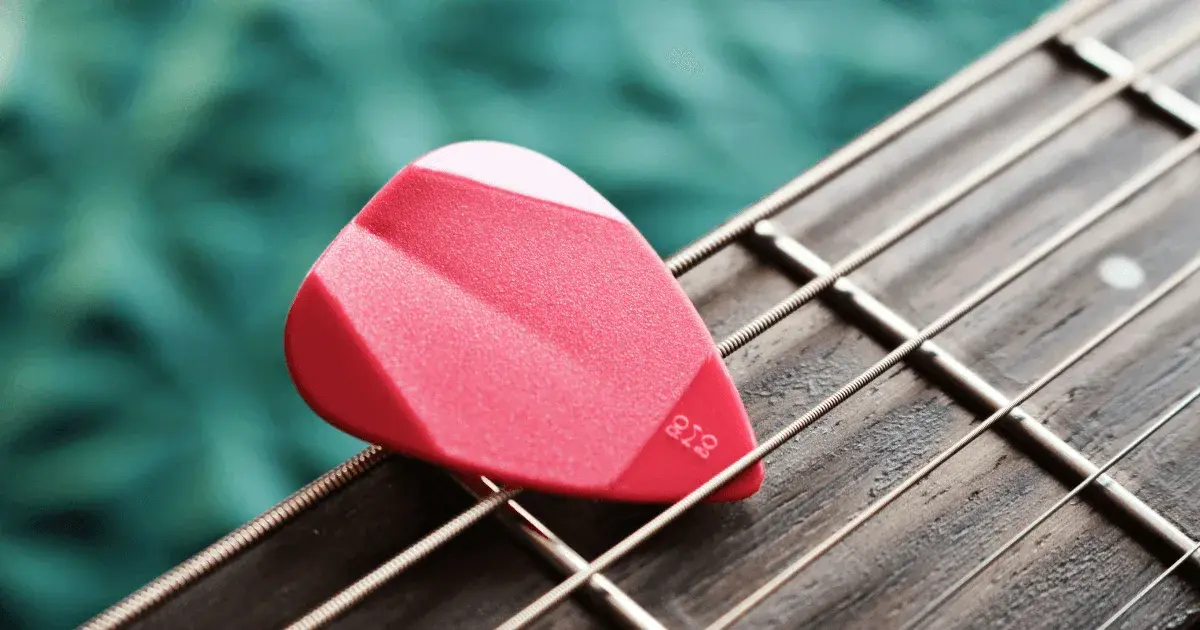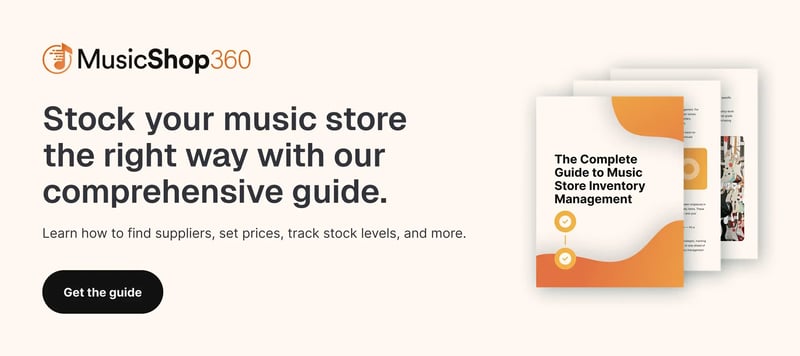
Are you a music store owner constantly wondering which instruments are truly bringing in profits and which are just collecting dust? It’s easy to get swept up in the glamour of big-ticket items. But what if the real money-makers are hiding in plain sight, often overlooked in favor of the flashier, more expensive gear?
In this blog, we dive into the often-surprising reality of gross profit margins across different product categories in your music store.
We’ll show you why a humble pack of guitar strings could be a bigger win for your bottom line than a shiny $2,000 guitar that sits on your showroom floor for months. Get ready to shift your perspective and learn how to get the most from your inventory for maximum profit.
Let’s get started.
Gross Profit Margin: The Big Picture
Gross profit margin is the percentage of revenue you keep after subtracting the cost of goods sold (COGS). For example, if you buy a guitar for $500 and sell it for $1,000, your gross profit is $500, and your gross profit margin is 50%.
The overall gross profit margin for a music store typically falls in the 20–40% range for instruments and gear. That said, the store’s overall profitability (net profit) is much lower, usually 5–15%, after accounting for major expenses like rent, utilities, and labor.
It’s important to remember that not all products contribute equally to your gross margin, and to know how each one contributes. Understanding which items have the highest margins can help you make more informed purchasing decisions and increase your overall profitability.
High-Margin Instruments That Actually Make Money
The distinction between “big-ticket items” and “high-margin items” is crucial. You need to know which products simply cost more and which actually yield more profit.
Top-Performing Accessories
This is where the real money is made. These items make up a small part of the overall sale but carry an astronomical markup. They’re often impulse buys or consumables that customers need to purchase regularly.
Examples:
- Strings and reeds: A pack of strings might cost you less than a dollar wholesale but sell for $5–$10, giving you a profit margin of 80% or more.
- Cables: These can have a markup of over 100%. A $20 cable might only cost you $2–$5.
- Picks, drumsticks, and drumheads: Customers need to replace these constantly. A well-stocked selection of these consumable products creates recurring revenue and opportunities for additional purchases.
- Music stands, straps, and tuners: These essential items also earn you healthy margins. Some of them can even help you identify serious musicians who are likely to respond well to upselling opportunities.
Related Read: 19 Social Media Marketing Ideas for Music Stores
Specialty & Niche Instruments
While everyday accessories deliver solid margins, certain instrument categories can also be very profitable.
Examples:
- Digital keyboards and synthesizers: These often have higher margins than acoustic or string instruments, making them a smart category to feature prominently.
- Custom or niche instruments: Rare, vintage, or boutique guitars can be sold at a premium, boosting your profit margin. Custom-built and unique wind or string instruments let you add value and charge more. Because they’re less subject to price-matching competition, you can often command higher markups and attract serious players looking for something special.
- Used gear: On platforms like Reverb, used gear can have margins of 35–40% or more, with the added benefit of faster turnover compared with new gear.
Instruments That Return a Lower Margin
This isn’t to say you shouldn’t stock these items, but it’s important to understand their role. They’re often “loss leaders” or products you need to carry to attract customers, even if they don’t deliver a high profit margin.
Big-Ticket, Lower-Margin Instruments
These high-value instruments often draw customers into your store and make up a significant portion of your overall sales revenue. While they might not have the highest gross profit margins individually, they’re essential for a balanced inventory and for positioning your store as a serious destination for musicians.
Examples:
- Premium guitars and basses: High-end Fender, Gibson, Paul Reed Smith Guitars, and similar brands carry prestige and higher price points. Even still, competitive wholesale pricing can lead to lower percentage margins.
- Acoustic and grand pianos: These are arguably the largest and most expensive items in your music store. They require significant capital investment and specialized handling, including climate-controlled storage, which can eat into their already tight margins.
- High-end drum kits: While drum accessories can be very profitable, complete, professional kits are major purchases. Competition and the sheer size and storage requirements can reduce their overall margin compared to smaller items.
- Pro audio equipment: Studio monitors, mixing consoles, and professional microphones can be expensive and attract discerning customers, but their margins are often smaller due to the competitive nature of the pro audio market.
Mass-Produced, High-Volume Instruments
- Mass-produced guitars: While essential for attracting customers to your store, these instruments are often sold at lower markups due to intense online competition and Minimum Advertised Price (MAP) policies.
- Student-grade instruments: These items often have low profit margins because they’re highly price-sensitive and widely available.
High-volume products don’t always translate to higher profits. These are just some of the reasons why it’s important to keep an eye on your music store’s gross profit margin.
Hidden Costs That Impact Margins
Even if your gross margins look healthy on paper, hidden costs can quietly erode your profits. From storage and insurance to slow-moving stock, these behind-the-scenes expenses can eat into your bottom line faster than you think.
Storage Space for Large Items
Storing large items in a music store creates several complexities and costs that can impact your margins. Understanding these issues can help you make better decisions about inventory management and how you use your space.
Here are some of the key challenges and expenses associated with storing large items:
- Real estate costs: Large instruments — like grand pianos, drum kits, or large speaker cabinets — take up significant floor space. This means you’re paying more in rent or mortgage costs per item compared with smaller accessories.
- Handling and labor: Moving and displaying heavy items often requires multiple staff members or specialized equipment. For instance, a grand piano typically needs professional movers.
- Reduced display space: Oversized inventory can occupy valuable showroom space that could be used for a wider variety of products or more engaging displays.
Insurance on Expensive Gear
One often-overlooked, but critically important, aspect of managing your music store’s finances is insuring expensive gear. While the appeal of high-ticket items — like player pianos, vintage guitars, or professional-grade sound systems — is undeniable, the financial risk of theft, damage, or loss is substantial.
These are the types of small business insurance for a music store, key policies, and their average monthly costs:
- Business owner’s policy (BOP): At about $95 per month, this often combines general liability ($42 per month) and property insurance.
- Workers’ compensation: These plans usually cost around $86 per month per employee.
- Commercial auto: Coverage for business vehicles runs about $171 per month.
- Cyber insurance: This typically costs $57 per month for data protection.
- Commercial umbrella insurance: This policy extends the protection of your general liability coverage and can cost about $59 per month.
Costs of Holding Slow-Moving Inventory
Holding onto inventory that doesn’t sell quickly comes with carrying costs that slowly chip away at your profits and tie up cash you could use elsewhere. Understanding and managing these costs helps you maintain a healthy bottom line.
Determining your music store’s gross profit margin means looking at your COGS in relation to sales revenue for each product category. When you know which instruments deliver the strongest margins, you can make smarter decisions about what to stock and how to prioritize your inventory.
Here are a few ways to get the most out of your product selection:
- Focus on stocking a balanced mix of guitars, ukuleles, and percussion instruments to maximize profitability.
- Carry a variety of accessories and sheet music — they complement instrument sales and offer strong margins.
- Keep your local market and customer base in mind when deciding which lower-margin instruments to stock. If there’s demand, they can still be worth carrying.
- Use your point of sale (POS) analytics to track sales and margins by category so you can refine your inventory strategy over time.
If you want to boost profits at your music store, focus on stocking instruments that sell well and deliver strong margins.
The Bottom Line: It’s All About the Mix
You can’t run a music shop by just selling guitar picks. Popular instruments, like guitars, are what bring people into your store. They generate the high-dollar sales that contribute significantly to your overall revenue.
The secret to a profitable music store is a strategic balance:
- Stock a variety of instruments to attract a broad customer base, even if some have thin margins.
- Maximize the sale of high-margin accessories through upselling and smart merchandising. For example, train your employees to always suggest an upgraded strap, a tuner, or a cleaning kit with every guitar purchase.
- Diversify your revenue streams beyond just product sales. Services like music lessons, rentals, and repairs can yield profit margins of up to 80% and are essential for a healthy bottom line. They also help build customer loyalty and generate repeat business.
Ultimately, fine-tuning your gross profit margin comes down to strategically balancing your inventory with a diverse mix of instruments and accessories — along with additional services — to make your profitability sustainable.
Related Read: Inventory Management System for Music Stores: 5 Features [+ 5 Top Providers]
Enhance Your Music Store’s Profitability With a Smart POS System
Effectively managing your music store’s inventory — and knowing the true profit potential of each product category — is key to long-term success. Balancing staple instruments with essential accessories can help create a more profitable and resilient business.
Using an all-in-one POS system makes it easier to manage inventory and maximize your profits. With features like real-time inventory tracking, Music Shop 360 helps you monitor stock levels efficiently and take full advantage of the fast-moving, high-margin items. Detailed sales and margin analytics give you insights into which products are most profitable, allowing you to refine your inventory strategy.
Ready to transform your music store’s operations and discover which products are the most profitable? Schedule a demo today to see firsthand how our system can help.








 by Taylor Harnois
by Taylor Harnois


